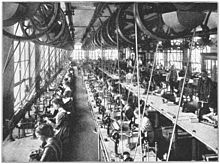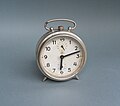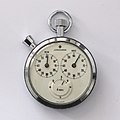Junghans
| Watch factory Junghans GmbH & Co. KG
|
|
|---|---|
| legal form | GmbH & Co. KG |
| founding | 1861 |
| Seat | Schramberg , Germany |
| management | Matthias Stotz |
| Number of employees | 110 |
| Branch | Clocks |
| Website | www.junghans.de |
| As of December 31, 2018 | |
Junghans is a watch manufacturer that was founded in Schramberg in the Black Forest in 1861 and was the largest watch manufacturer in the world with over 3000 employees at times.
Today the Junghans brand name is run by two independent companies, the watch factory Junghans GmbH & Co. KG and the Junghans Microtec GmbH , which manufactures defense technology. Both companies emerged from the former Gebrüder Junghans AG .
Company history
In 1860 the businessman Erhard Junghans founded an oil mill together with his brother-in-law Jakob Zeller-Tobler in Schramberg, which, however, was an economic failure. In 1861 Erhard Junghans founded the Junghans company in Schramberg with his brother Xaver Junghans, who had returned from the USA. At first, case parts were manufactured for other watch manufacturers in the Black Forest. The first clockworks could be produced from 1866/67. Daily production in 1870 was around 60 watches.
Erhard Junghans died in autumn 1870, after which the widow Luise Junghans took over the management of the company. On July 1, 1875, the Junghans company was transferred from Luise Junghans to the sons Erhard the Elder. J. and Arthur sold; According to the partnership agreement, the older son Erhard (d. J.) took over both commercial and technical management. In the years after the takeover, Arthur Junghans, who had previously worked in American watch factories for a year, initiated a series of technical modernizations. At the end of the 1870s, Junghans also started manufacturing alarm clocks based on the American model, which led to a strong expansion of the company. As early as 1883 and again in 1894 Arthur Junghans tried to set up a production facility for simple pocket watches . However, a series of failures forced these efforts to be halted again. Through the merger with the Schwenningen-based company Thomas Haller AG , which had been successfully manufacturing and marketing pocket watches since the mid-1890s, Junghans was able to expand its range to include pocket watches from 1900 onwards.
In 1888 the company presented a five-pointed star with a “J” in the middle as a trademark . This star received eight points in 1890 and is still the company's trademark today. In 1903 Junghans was the world's largest watch manufacturer with more than 3,000 employees and a production of over three million watches per year. In 1906 Junghans also started manufacturing ammunition fuses, which were produced in large quantities in Schramberg during the First World War.
Junghans began producing wristwatches in 1928, initially using works from Gebrüder Thiel GmbH in Ruhla . From 1930 Junghans produced its own works. At the same time, the collaboration with the French ATO and the production of the electric pendulum clocks of the same name began until 1962.
After the seizure of power of the Nazis Junghans was developed by General Erwin Junghans (* 1875, † 1944, son of Arthur Junghans) geared to military production. Junghans applied and received numerous armaments orders (precision clocks for aircraft and ships as well as ammunition fuses of all types) due to the war preparations. During the war years, over 9,000 employees mainly produced fuses and other armaments in bomb-proof rooms in Schramberg . Fuzes developed by Junghans were also manufactured on a very large scale by other companies, particularly in Pforzheim, which led to the total destruction of Pforzheim by the Allies. Junghans founded branches for the manufacture of armaments equipment in other cities under a neutral name (e.g. "MESSAP" in Hamburg). In Mühlheim an der Donau, Junghans and the Mühlheim watch factory had their own firing range for testing ammunition.
In 1942, 440 " Eastern workers ", 332 prisoners of war and forced laborers from France and 90 forced laborers from Poland were housed at Junghans in Schramberg . The French workers were mostly quartered in shared accommodation or inns, while the Soviet and Polish workers lived in barracks. After the end of the Second World War, essential machines were dismantled by the French military administration and taken to France, but the production of civilian watches could be resumed as early as 1946. Various company buildings were confiscated as barracks by the Allies for a while. Junghans was also forced to deliver loose watch movements to France, which, however, were not sold in France, but under the logo of French watch manufacturers abroad.
After the war, Junghans concentrated on producing good quality wristwatches in order to regain reputation with customers. As a result, Junghans developed into the largest manufacturer of chronometers in Germany in the 1950s, for example with the Junghans chronometer for around DM 160 with the movement caliber J 85, which was launched on the market in the early 1960s .
As part of a hostile company takeover by Diehl in Nuremberg , the Junghans family lost the company and management in 1956. The official takeover of the company took place on November 15, 1956. The Diehl Group continued the watch and ignition technology branches separately.
In 1972 Junghans provided the official timekeeping for the Summer Olympics in Munich .
Since 1984 there have been two organizationally separate companies: the watch factory Junghans GmbH & Co. KG and the Junghans Microtec GmbH.
In 1986 Junghans presented a radio-controlled table clock, one of the first commercial radio- controlled clocks in the world. 1990 followed with the digital MEGA 1, the world's first radio-controlled wristwatch, and in 1991 the analogue version Junghans Mega came onto the market. The design was created by frog design . In 1995 Junghans presented a combination of radio-controlled wristwatch with solar drive and ceramic case, the MEGA Solar Ceramic .
The Diehl Group sold the watch division in 2000 to the holding company Egana Goldpfeil ; the defense technology and the company building in Schramberg remained with Diehl. The watch division employed around 220 people at that time, and defense technology 350.
In 2004 Junghans presented the first multi-frequency radio-controlled wristwatch that receives signals from the time signal transmitter DCF77 in Europe, JJY in Japan and WWVB in the USA.
The “Erhard Junghans” brand was introduced in 2006 as a homage to the company's founder.
Junghans Uhren GmbH filed for insolvency on August 29, 2008 after the parent company Egana Goldpfeil had run into financial difficulties shortly before. At that time the company had 115 employees. On January 22nd, 2009, the insolvency administrator announced that a buyer had been found for Junghans Uhren GmbH. The Schramberg entrepreneur Hans-Jochem Steim and his son Hannes Steim took over the business operations and all divisions of the company on February 1, 2009, which has been operating under the name Uhrenfabrik Junghans GmbH & Co. KG since February 1, 2009 . In the year of the takeover, the watch factory Junghans GmbH & Co. KG achieved a double-digit percentage increase in sales.
In 2011 Junghans celebrated the company's 150th anniversary with limited models and reinterpretations of historical series.
The historically significant and listed terrace building, designed and built in 1917/1918 by the German architect Philipp Jakob Manz , was restored under the supervision of the Monument Office and opened to the public in the form of a museum in June 2018. The focus of the Junghans Terrassenbau Museum is on Black Forest clocks, clocks with musical equipment and the history of the clock factory.
In July 2018, Junghans presented the new J101 radio-controlled movement, which for the first time enabled a classic radio-controlled watch design.
Clocks
The watch brand Junghans includes all watch technologies. The mechanical segment includes hand-wound and automatic models , some with complications such as power reserve , calendar week display , moon phase , chronograph , etc. Design classics of the max bill by junghans logo are based on original designs by the Bauhaus artist Max Bill . The technology division offers radio-controlled clocks with Junghan's own radio movements that receive time information from the European DCF77 , the American WWVB and the Japanese JJY transmitter. Conventional button cells or modern solar technology provide drive energy . The in-house solar / quartz development has been on the market since 2011. The quartz movements are sourced around the world . Special high-tech materials such as titanium and ceramics are combined with radio and solar technology. With the Erhard Junghans brand, mechanical movement production is pushed forward again. The clocks at prices between 249 and 18,000 euros are produced in Schramberg.
Junghans clock in the Sultan's Palace of Yogyakarta
Kitchen clock designed by Max Bill in 1956
Others
- In 2011, descendants of the Junghans family gave Hans-Heinrich Schmid , the author of the Lexicon of the German Watch Industry 1850–1980 , an insight into the Junghans family archive , which was previously inaccessible. By studying these documents, many questions about the early history of the Junghans family business could be clarified. These documents, including Arthur Junghans' notebook from his time in America, are now in the Schramberg City Archives.
- When the "Landshut" plane was hijacked in 1977, the copilot Jürgen Vietor had to destroy his Junghans wristwatch because the Palestinian kidnapper Zohair Youssif Akache thought the logo was the Jewish Star of David .
literature
- Hans-Heinrich Schmid : Lexicon of the German watch industry 1850–1980: company addresses, production program, company logos, brand names, company histories. (3rd extended edition 2017), publisher: Deutsche Gesellschaft für Chronometrie eV; ISBN 978-3-941539-92-1
- Franz Ludwig Neher : A Century of Junghans. Schramberg 1961.
- Kerstin Simon: 150 moments from 150 years of Junghans . ISBN 978-3-00-034264-6 .
- Martin Fischer: Fascination Junghans - Seven decades of wristwatches from Schramberg . ISBN 978-3-86646-150-5
Web links
- Official website
- Early documents and newspaper articles on Junghans in the 20th century press kit of the ZBW - Leibniz Information Center for Economics .
- Junghans, Max Bill and the kitchen time in context
- Junghans, company history and watch models (watch wiki)
- Museum portal Schleswig-Holstein wall clock, 4th quarter of the 19th century
- Official Inventor Times website. Museum of the Schramberg car and watch world
- Website Junghans Terrassenbau Museum Schramberg
Individual evidence
- ↑ FL Neher: "A Century of Junghans" - company publication for the 100th anniversary of Junghans Schramberg in 1961
- ↑ Lexicon of the German Watch Industry 1850-1980 Volume 2, pp. 218/219
- ↑ 1888 - The Junghansstern rises. junghans.de, accessed on November 19, 2014
- ↑ ATO - Watches accessed on January 18, 2015
- ↑ Junghans watch factory: The living and working situation of forced laborers denktag-archiv.de (accessed on December 28, 2014)
- ↑ Schramberg - City of Clocks schramberg.de (accessed December 28, 2014)
- ↑ Gisbert L. Brunner : Mechanical wrist chronometer from the Junghans manufacture in Schramberg. In: Old clocks. No. 4, 1982, pp. 312-320.
- ↑ Lexicon of the German Watch Industry 1850-1980 Volume 2, p. 221.
- ^ Helmut Kahlert , Richard Mühe , Gisbert L. Brunner: Wristwatches: 100 years of development history. Callwey, Munich 1983; 5th edition, ibid. 1996, ISBN 3-7667-1241-1 , pp. 47-58.
- ↑ Lexicon of the German Watch Industry 1850-1980 Volume 2, p. 222.
- ↑ Die ZEIT 40/2002: Inventions: Who invented it? Radio controlled clock ( Memento from December 31, 2014 in the Internet Archive )
- ↑ Handelsblatt: watch manufacturer Junghans insolvent (September 1, 2008)
- ↑ Buyer for Junghans watches found ( Memento from January 23, 2009 in the Internet Archive ) (January 22, 2009)
- ↑ Martin Knobbe on the kidnapping of the Landshut. Stern.de . Retrieved May 12, 2018.
Coordinates: 48 ° 13 ′ 20.5 ″ N , 8 ° 22 ′ 44.4 ″ E
























